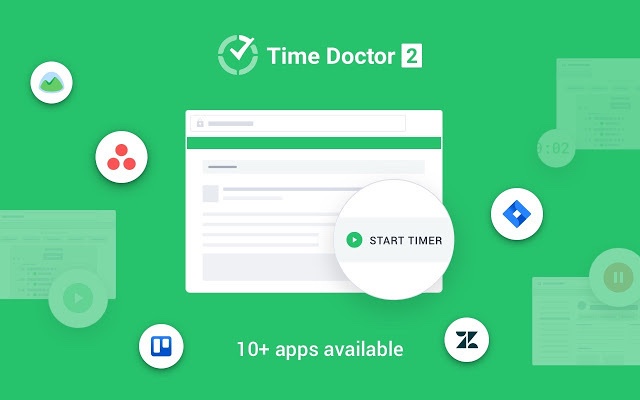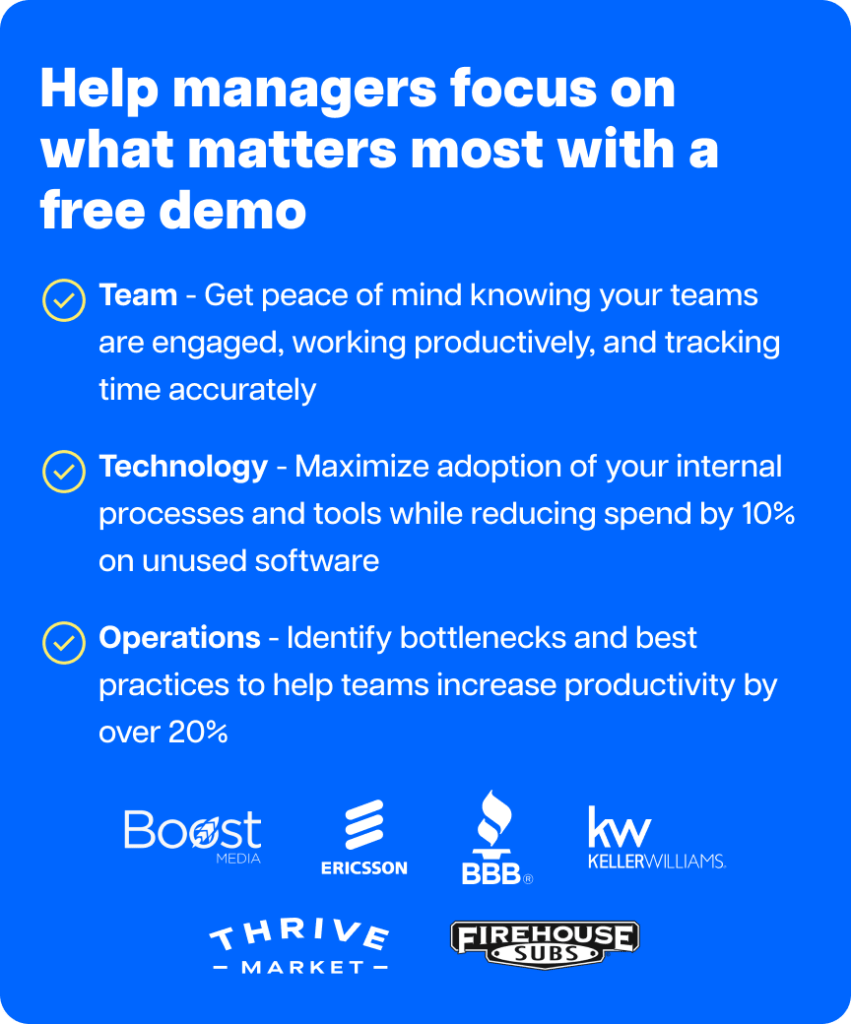Wondering how to measure productivity of employees working from home?
While remote work helps employers reduce costs, it also offers a better work life balance to employees, who benefit from increased productivity. And with the current COVID-19 pandemic, transitioning to remote work has become the default option for thousands of companies.
However, as your employees are no longer in the same office space, many employers are left wondering how to measure their productivity.
In this article, we’ll tell you how to measure productivity of employees working from home.
We’ll highlight some metrics you can use to determine employee performance and give you some tips to help your remote employees boost their productivity at home.
This article contains:
How To Measure Productivity Of Employees Working From Home
- Sales Performance Metrics
- Marketing Performance Metrics
- Support Performance Metrics
- HR Performance Metrics
7 Tips To Ensure High Productivity Rates Among Remote Employees
Let’s jump in.
How to measure productivity of employees working from home
You can’t measure employee performance based on guesswork, right?
After all, your employees’ productivity is tied directly to your business’ growth.
And while it can be easy to measure the performance of in-house office workers, employee monitoring for a remote workforce may not be that simple.
Don’t worry.
You can use KPIs (Key Performance Indicators) to measure the productivity level of all your remote employees.
But what are KPIs exactly?
KPIs are quantifiable measures that analyze your business’s and employee’s performance based on its key goals and objectives.
Here are some KPIs that’ll help you measure the performance of your remote employees:
A. Sales performance metrics
Let’s take a look at three metrics that’ll help you measure your remote sales employees’ productivity:
1. Sales per rep
This productivity metric helps you see how many sales each remote agent has closed — which is a direct measure of how effective they are at selling your product or service.
However, it’s important to remember that the average number of sales can differ based on the employees’ experience, customer base and seniority.
2. Revenue per sales agent
The revenue per agent is a productivity metric that shows you how efficient your entire remote sales team is. To calculate it, just take your annual sales and divide it by the number of sales agents in your team.

It’ll also give you a clear idea of how much each agent has contributed to your company’s revenue on average, showing you how productive your sales team is when working from home.
3. Lead to win conversion rate
The lead to win rate is a popular KPI that measures the productivity of sales employees.
It counts the number of leads that entered your sales funnel against the number of confirmed transactions.

This is a great telework metric that’ll give you an accurate picture of how efficient your sales team is at closing deals.
B. Marketing performance metrics
These metrics will help you measure how productive your remote marketing team is:
1. Website lead conversion rate
The lead conversion rate shows you how many website visitors were successfully converted to leads. This productivity metric is great for remote teams as it highlights how well you can attract the right audience and how valuable your website is at converting visitors to leads.

2. Overall engagement
This metric is used by marketing teams to measure their brand’s performance on social media platforms.
Overall engagement essentially measures how active your followers are. With it, you can view the number of likes, retweets, comments and shares and see how engaged your fanbase is.
This metric is a great way to see if your content resonates with your audience, or whether you need to tweak your marketing strategy to gain more active followers.
3. Return on marketing investment (ROMI)
This KPI gives business owners/managers an idea of how profitable their marketing efforts are. It compares the running cost of a marketing campaign to the revenue generated from the campaign.

C. Support performance metrics
These three metrics will be useful if you manage a remote support team:
1. Call volume
Call volume measures the total number of incoming or outgoing calls depending on the nature of your call center.
For example, if you run an outbound call center, a high number of outgoing calls translate to a more productive remote support team.
2. Average speed to answer
Customers don’t like to stay on hold for a long time, so this metric is a key customer satisfaction indicator. It measures the average amount of time taken for a worker to answer an incoming query.

Unlike most other metrics, a higher value here doesn’t translate into a better result.
After all, the goal is to keep average response times as low as possible. If you have a high average speed to answer, your call agents aren’t productive enough, or your support team is understaffed.
3. Customer satisfaction score (CSAT)
The CSAT is a commonly used KPI to measure how satisfied customers are with your service. It’s measured by a question that asks customers to rate their satisfaction on a scale of 1 (very unsatisfied) to 5 (very satisfied).
You can obtain the average of these scores to see how satisfied customers are with your service in general. A high CSAT score translates to increased productivity of your support team, and it’ll result in high customer retention rates.
D. HR performance metrics
If you’re worried your HR team is not being productive from home, just use these metrics to see how they’re doing:
1. Profit per employee
This KPI takes the profit for the previous 12 months of the business and divides it by the number of full-time employees in the company.

But how does this metric tie in with HR performance?
If the average profit per employee is low, it means that your HR team is hiring unsuitable candidates or is failing to train your remote worker teams effectively.
2. Expenses per employee
This metric gives you an idea of how much you have to spend on an average employee, and it’s also known as an efficiency metric.
The expenses per employee KPI takes the operating cost of the previous 12 months and divides it by the number of employees.

If your expenses per employee are high, your HR team will have to do a better job — whether it’s hiring cheaper talent or reducing worker hiring costs.
3. Annual employee turnover rate

The employee turnover rate is divided into voluntary and involuntary turnover rates. Companies usually calculate turnover rates separately, so they can focus on reducing voluntary turnovers.
Voluntary turnover deals with people who have left your business, while involuntary turnovers refer to people who are fired, retired or lose a certification that prevents them from practicing.
Understanding the reasons for voluntary turnover can help you improve company culture and increase your employee retention rates.
7 tips to ensure high productivity rates among remote employees

Knowing how to measure employee productivity isn’t enough.
You need to know how to boost your employees’ work productivity if you want your business to grow.
So here are seven tips that’ll help you increase productivity rates among your remote workers:
1. Be results-oriented
Do you think employees who work longer hours get more tasks done?
That’s not always true.
Some employees can sit in front of a computer for eight hours and get next to nothing done, while another worker can breeze through their tasks in a couple of hours.
Instead of paying people for working longer hours, promote a results-oriented culture that rewards employees based on their output. This way, your employees will focus on completing more tasks in the shortest time possible, helping your business grow quickly.
2. Document work processes
Every remote employee has had times where they wanted to clarify something from someone, only to find that the relevant person was offline.
While such instances can lead to workflow bottlenecks, you can easily avoid them by documenting your processes.
Think about it.
When everything your employees have to know about their task is detailed in a cloud service like Google Drive, they won’t have to wait around to clarify anything — they can just read the guide and get back to work!
Creating a resource library will even help you cut down on onboarding times for new hires too. Just remember to store your documentation in cloud storage, where everyone can access it easily.
3. Set deadlines and give clear goals
Every business faces problems when a task isn’t completed on time.
Setting a timeframe for tasks is essential if you want your employees to stay productive and keep your business running like clockwork. Timeframes not only help to get your deliverables completed on time, but they also motivate your employees to finish the task on time.
Additionally, if you don’t have clear expectations from your remote staff, your employees might take their work lightly and become unproductive — especially since they work from home.
Setting personal and team goals make employees realize what’s expected of them, and helps them work towards their goals quickly.
4. Track progress regularly
If you manage a team of office workers, you’d constantly monitor your employees while they’re at work.
However, when employees are working from home, there aren’t many ways to keep tabs on what they’re working on. And if you stop checking in, they might tend to slack off on their work.
That’s why it’s essential to check in with your workers using a video conferencing app like Zoom or Microsoft Teams. Hold meetings with your team or individually to see how your employees are going on about their work.
You can also use a time tracking tool or employee monitoring software to analyze each employee’s productivity levels during a day.
Doing so shows your employees that their employer knows what they’re doing, helping them pay more attention to the task they’re working on.
5. Encourage communication between remote employees
Remote working can be tough.
You mostly work by yourself and there are no colleagues to share a break or go out to lunch with.
This can sometimes cause rifts or miscommunications between your team members. Not only will this hurt interpersonal relationships, but they’ll also disrupt the flow of your work.
Encourage your employees to stay in contact with each other. This will help them understand each other better and lead to lesser team conflicts. You can also use virtual team building activities to improve team chemistry.
Fewer disagreements will allow your remote team to focus more on work and achieving company goals easily.
6. Be transparent with employees
As remote teams are physically distant, it’s harder to build trust among them. There are fewer ways to meet in person, which can make it tougher to build relationships.
As a result, if you make strategic decisions all by yourself, it can make your employees feel disconnected from the big picture.
Being transparent with your employees shows that you value them, and helps them communicate openly with you and the rest of the team — which, in turn, improves employee engagement.
Transparency will also ensure that your team knows the ups and downs of your business, and they’ll respect you more as an employer for trusting them.
7. Use a productivity monitoring tool
When your team works in-house, you can supervise them directly.
But when they are spread out remotely, how do you monitor what they’re doing and continue tracking productivity?
For this, you’ll need to use an employee productivity tracking tool that helps you keep track of what your remote employees are up to when working from home.
Luckily, Time Doctor can help you with all that and more!
What is Time Doctor?

Time Doctor is a popular time tracking and productivity monitoring software used by large companies as well as SMBs to measure team productivity effortlessly.
Time Doctor is a tool that:
- Tracks how much time is spent on each task.
- Prevents team members from idling during working hours.
- Produces real-time productivity tracking reports that detail stats over a given time period.
To make your workday more productive, you can also use the Chrome extension to track time across a range of project management apps like Jira, Trello and ClickUp.
Note: Time Doctor tracks teleworker activity only during their work hour to safeguard privacy.
Final thoughts
The question of how to measure productivity of employees working from home can seem like a challenging one — especially if you’re used to managing a team of in-house office workers.
However, accurate productivity measurement of your remote workers is now an important task for most companies. And with the Coronavirus pandemic and subsequent rise of remote working, remote productivity assessment has never been more vital.
However, that doesn’t mean you need to worry about it too much as an employer.
When done effectively, it helps you boost your output and develop your workers into highly productive employees.
Just follow the tips we’ve mentioned in this article, and you’ll be able to set up a productivity measurement system in no time.
Remember to use the metrics we mentioned in this article and combine them with productivity apps like Time Doctor to skyrocket your remote team’s productivity in no time!

Liam Martin is a serial entrepreneur, co-founder of Time Doctor, Staff.com, and the Running Remote Conference, and author of the Wall Street Journal bestseller, “Running Remote.” He advocates for remote work and helps businesses optimize their remote teams.


